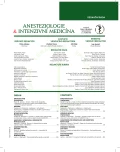Long-term treatment and addiction to opioids
Authors:
J. Lejčko 1; T. Gabrhelík 2
Authors‘ workplace:
Klinika anesteziologie, resuscitace a intenzivní medicíny, Centrum léčby bolesti, Univerzita Karlova
Lékařská fakulta v Plzni, Fakultní nemocnice Plzeň
1; Anesteziologicko-resuscitační oddělení Krajské nemocnice Tomáše Bati Zlín, a. s.
2
Published in:
Anest. intenziv. Med., 28, 2017, č. 2, s. 106-113
Category:
Overview
Chronic pain is a serious public health concern. Under-treatment of chronic pain causes intense physical and psychological suffering and can destroy patient’s quality of life. Experience with long-term opioid analgesia in patients with cancer pain has shown highly favourable risk/benefit ratio. Where standard therapeutical methods have failed, patients can be treated by administration of strong opioids. However, opioid treatment has its issues. Life expectancy of chronic pain patients is temporarily unlimited and for that reason the time horizon of opioid therapy is unlimited as well. The effect of opioids on the organism is very complex. In comparison with cancer pain, opioid responsiveness to chronic non-cancer pain is somewhat different. Clinical experience has shown that exceeding medium-sized doses of opioids in the treatment of chronic non-cancer pain does not lead to further improvement of analgesia, but only increases degree of physical dependency and tolerance. Therefore, from a clinical point of view, opioids in chronic non-cancer pain should be regarded as substances with a ceiling effect. In some patients medicated with opioids, dependency can appear to be the dominant clinical problem that might be difficult to distinguish from addiction. Management of withdrawal symptoms may enhance pain control, mental state and compliance with pain management.
Keywords:
opioids – physical dependency – addiction – withdrawal syndrome
Sources
1. Eriksen, J., Sjogren, P., Bruera, E. et al. Critical issues on opioids in chronic non-cancer pain: an epidemiological study. Pain, 2006, 125, 1–2, p. 172–179.
2. Machikanti, L., Singh, A. Therapeutic opioids: A ten-year perspective on the complexities and complications of the escalating use, abuse and nonmedical use of opiids. Pain Physician, 2008, 11, 2 Suppl., p. 63–88.
3. Cohen, S. P., Christo, P. J., Wang, S. et al. The effect of opioid dose and treatment duration on the perception of a painful standardized clinical stimulus. Reg. Anesth. Pain Med., 2008, 33, 3, p. 199–206.
4. Moore, R. A., McQuay, H. J. Prevalence of opioid averse events in chronic non-malignant pain: systematic review of randomised trials of oral opioids. Arthritis Res. Ther., 2005, 7, 5, p. R1046–R1051.
5. Portenoy, R. K. Opioid therapy for chronic nonmalignant pain: a review of critical issues. J. Pain Symptom Manage, 1996, 11, 4, p. 203–217.
6. Chou, R., Fanciullo, G. J., Fine, P. G. et al. Clinical guidelines for the use of chronic opioid therapy in chronic noncancer pain. J. Pain, 2009, 10, 2, p. 113–130.
7. Lejčko, J. Chronická bolest, opioidy a závislost – jdeme správným směrem? Bolest, 2015, 18, 4, p. 186–193.
8. Savage, S. R., Joranson, D. E., Covington, E. C., Schnoll, S. H., Heit, H. A., Gilson, A. M. Definitions related to the medical use od opioids: evolutions towards universal agreement. J. Pain Symptom. Manage, 2003, 26, 1, p. 655–667.
9. Jaffe, J., Martin, W. Opioid analgesics and antagonists. In: Gilman, J. The pharmacological basis of therapeutics. 1st ed. New York: Mac-Millan, 1980, p. 491–531.
10. Portenoy, R. K., Lesage, P. Management of cancer pain. Lancet, 1999, 353, 9165, p. 1695–1700.
11. McQuay, H. J. Opioid use in chronic pain. Acta Anaesthesiol. Scand., 1997, 41, 1, p. 175–183.
12. Weissman, D. E., Haddox, J. D. Opioid pseudoaddiction – an iatrogenic syndrom. Pain, 1989, 36, 3, p. 363–366.
13. Compton, P., Darakjian, J., Miotto, K. Screening for addiction in patients with chronic pain and „problematic substance“ use: evaluation of a pilot assessment tool. J. Pain Symptom Manage, 1998, 16, 6, p. 355–363.
14. American Psychiatric Association Diagnostic and statistical manual of mental disorders. 5th ed. Arlington, VA: American psychiatric Publishing, 2013. ISBN 978-0-89042-554-1.
15. Ballantyne, J. C., Stannard, C. New addiction criteria: diagnostic challenges persist in treating pain with opioids. Pain Clinical Updates, 2013, 21, 5, p. 1–7.
16. Robinson, T. E., Berridge, K. C. Addiction. Annu. Rev. Psychol., 2003, 54, 1, p. 25–53.
17. Woodcock, J. A difficult balance – pain management, drug safety and the FDA. N. Engl. J. Med., 2009, 361, 22, p. 2105–2107.
Labels
Anaesthesiology, Resuscitation and Inten Intensive Care MedicineArticle was published in
Anaesthesiology and Intensive Care Medicine

2017 Issue 2
Most read in this issue
- Deep vein thrombosis and pulmonary embolism in pregnancy
- Dexmedetomidine and its use in anaesthesia and intensive care
- Inhalational application of furosemide – the breathlessness panacea?
- The physician and the law II – forensic medical experts and expert institutions
